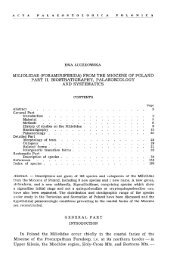Full text - Acta Palaeontologica Polonica
Full text - Acta Palaeontologica Polonica
Full text - Acta Palaeontologica Polonica
You also want an ePaper? Increase the reach of your titles
YUMPU automatically turns print PDFs into web optimized ePapers that Google loves.
346 ACTA PALAEONTOLOGICA POLONICA 56 (2), 2011<br />
Table 1. Summary comparative table of the diagnostic characters to discriminate ampullinids and naticids (considering anatomical and morphologi−<br />
cal characters from Kase 1990, and Kase and Ishikawa 2003a) supplemented with colour pattern features (this paper).<br />
Ampullinidae Naticidae<br />
Feeding habits Algal grazer Carnivorous predator<br />
Anatomical features – foot with small, flat, quadrangular propodium and massive, short<br />
metapodium;<br />
– foot with a large plow−like propodium;<br />
– head with a long extensible proboscis con−<br />
– wide, flat, bipartite and snoutless head without extensible proboscis taining the radula<br />
Morphological features – highly elevated and pointed spire;<br />
– tabulate whorls;<br />
– low spire with obtusely pointed apical<br />
whorls;<br />
– columellar lip lined abaxially with a sheath;<br />
– anterior tip of the columellar lip often expanding abaxially into a<br />
round lobe;<br />
– devoid of a sheath and developing instead<br />
one or more funicles;<br />
– species with small protoconch have<br />
– species with small protoconch have protoconch consisting of<br />
1.2–1.5 helicoidal, smooth and inflated whorls.<br />
protoconch consisting of 2.2–3.5<br />
planispirally and ornamented whorls.<br />
Colour pattern features – Classes II, III, IV;<br />
– Classes II, III, IV not observed;<br />
Class II<br />
– parallel zigzagging stripes;<br />
– non−parallel zigzagging stripes;<br />
– few zigzags per stripe;<br />
– numerous zigzags per stripe;<br />
– very heterogeneous zigzags’ amplitude.<br />
– homogeneous zigzags’ amplitude.<br />
Conclusions<br />
The study of the residual colour patterns provides much new<br />
morphological information on fossil Cainozoic species of the<br />
family Ampullinidae. The testing on Mesozoic species pro−<br />
vided up to now only negative results. Future observations of<br />
very well preserved material (e.g., Cretaceous from Northern<br />
America, Jurassic from Eastern Europe) nevertheless may<br />
complete the present study. The diversity of Cainozoic colour<br />
patterns appears to a greatest magnitude during the Middle<br />
Eocene, when the specific richness of the family is most pro−<br />
nounced, as observed in the stromboid family Seraphsidae<br />
(Caze et al. 2010).<br />
Firstly, we demonstrated that there is an obvious similarity<br />
between the residual pattern of fossil Globularia and that of<br />
the extant Globularia (Cernina) fluctuata. Secondly, in the<br />
other studied genera, some species display intermediate pat−<br />
terns suggesting a transition between Globularia and Ampul−<br />
lina (A. intermedia; Fig. 3) and between Globularia and<br />
Pachycrommium (Globularia (C.) sp.; Fig. 5).<br />
Otherwise the colour patterns of fossil ampullinids and<br />
naticids appear easily distinguishable (Le Meur 2009; Fig.<br />
11) and can be used as an additional diagnostic character to<br />
discriminate the two families (Table 1). Thus, although the<br />
request of Aronowsky and Leighton (2003) for more detailed<br />
morphological studies was correct, we can safely confirm the<br />
suggestion of Kase and Ishikawa (2003a) that fossil, or at<br />
least Cainozoic, and Recent ampullinids should be removed<br />
from Naticidae. Nevertheless, we should urge caution be−<br />
cause the species with the general colour pattern of class I are<br />
difficult to adjudicate. Finally, we believe that molecular se−<br />
quence data analyses would be helpful to resolve this ques−<br />
tion definitively and thus test the relevance of the use of UV<br />
light in such cases. Despite the existence of only a single liv−<br />
ing representative, we can assert that the colour patterns of<br />
Globularia remain almost unchanged from the Early Palaeo−<br />
gene to the Recent, the other patterns disappearing with the<br />
extinction of the other ampullinid genera.<br />
Acknowledgements<br />
We are indebted to Jacques Mouchart and Guy Varone (Bordeaux,<br />
France) who kindly gave their material for this study. We thank Phi−<br />
lippe Maestrati, Pierre Lozouet and Virginie Héros (MNHN) and Abel<br />
Prieur (all University of Lyon1, Lyon, France) for access to the collec−<br />
tions. Our thanks go also to Tomoki Kase (National Museum of Nature<br />
and Science, Tokyo, Japan), Jonathan Hendricks (San Jose State Uni−<br />
versity, San Jose, USA) and Jonathan Todd (Natural History Museum,<br />
London, UK) for their careful review of the manuscript. The photo−<br />
graphs have been taken by Christian Lemzaouda and Philippe Loubry<br />
(both MNHN). This study was made possible thanks to the research<br />
programs Plan Pluri Formation Etat et structure phylogénétique de la<br />
biodiversité actuelle et fossile (Dir. P. Janvier, MNHN) subprogram<br />
Atelier de terrain: biodiversité du gisement de la falunière de Grignon<br />
(Dir. D. Merle, MNHN) and Patrimoine géologique (Dir. P. de Wever,<br />
MNHN) subprogram Stratotype Lutétien (Dir. D. Merle).<br />
References<br />
Aronowsky, A. and Leighton, L.R. 2003. Mystery of naticid predation his−<br />
tory solved: Evidence from a “living fossil” species: Comment and Re−<br />
ply. Geology 31 (1): e34–e35.<br />
Bandel, K. 2006. Families of the Cerithioidea and related superfamilies<br />
(Palaeo−Caenogastropoda; Mollusca) from the Triassic to the Recent<br />
characterized by protoconch morphology−including the description of<br />
new taxa. Freiberger Forschungshefte C 511: 59–138.<br />
Caze, B., Merle, D., Pacaud, J.−M., and Saint Martin, J.−P. 2010. First sys−<br />
tematic study using the variability of the residual colour patterns: the<br />
case of the Palaeogene Seraphsidae (Gastropoda, Stromboidea). Geo−<br />
diversitas 32: 45–105.<br />
Comfort, A. 1949a. Acid−soluble pigments of shells. 1. The distribution of<br />
porphyrin fluorescence in molluscan shells. Biochemical Journal 44:<br />
111–117.
















